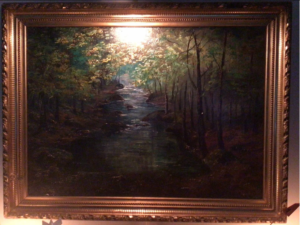A story has been making the rounds in the arts and culture sections of many respectable publications about the latest wonder pulled off by an artificial intelligence program. The Swiss company Art Recognition announced that one of its AIs identified about forty paintings available on the e-commerce site eBay that are most likely forgeries and counterfeits. While some may see this as an example of AI’s potential in art authentication and consumer protection, many seem to be focusing on the wrong issue here.
Art Recognition has been in the news several times over the past few years, mostly regarding AI’s capabilities in art authentication. The first time I wrote about the organization was in 2021 regarding their claims that a Rubens painting kept at the National Gallery in London is likely a later copy. They appeared again in the debates surrounding the De Brécy Tondo, a Madonna and Child painting that some dubiously attribute to Raphael. However, part of me grew suspicious when I saw these more recent headlines because there were too many incongruous details.
Firstly, it seemed suspicious to me that these paintings, some of them purportedly by Impressionist masters, were being offered on eBay, the same site people use to sell their old VHS tapes and Beanie Baby collections. A supposed Monet painting is listed on eBay at $599,000, a price tag you would expect from an auction room. The description reads, “I fully guarantee that the painting is an original 1867 oil on canvas signed and dated by Claude Monet. The painting is not in perfect condition and I do not have any provenance beyond me having it for over 20 years.” The Monet’s seller is based out of Millersburg, Ohio, a town of 3,000 people in the heart of Amish country, exactly where you would expect to find a random Monet painting. One of the other paintings was a supposed Renoir offered by an account from Florida.
Reading the coverage, I found that everyone writing about these counterfeit paintings focused on the wrong thing. Nearly all of them focused on how an AI could spot these fakes online, implying that many innocent people would have gotten their money stolen had it not been for this technological marvel. However, this leads to the second big incongruous detail. If you look at some images of the fake paintings for sale on eBay, you might come to the same conclusion we did: you don’t need an AI to tell you they’re fake. Requiring an AI to tell you that some of these are fakes is like insisting on checking someone’s pulse when their head is gone. They’re clearly dead, so you don’t need to complicate this any more than necessary; especially the case with the supposed Monet. Even as an alleged example of the artist’s early work, before his first Impressionist paintings in the 1870s, it’s so obviously a fake. At least for the alleged Renoir, it seems like something made by someone who has actually seen the artist’s work. It is unknown whether the painting’s current owner knows it’s a fake. For all we know, their prized possession being a fake might be a genuine surprise to them. Anyone who watches enough Antiques Roadshow or Pawn Stars will know that there’s lots of fake stuff out there, and there’s a big market for it among people who might not know any better. And that’s what these articles should have been focused on. Enough about the wonders of AI; why aren’t we talking about e-commerce sites like eBay being so under-regulated?
Art Recognition has tried to put pressure on eBay to dedicate greater amounts of time, effort, and resources to identifying and removing fake and counterfeit items. eBay is ready to boast about its precautions in identifying and removing fake and counterfeit items. According to eBay, they use “multiple layers of AI technology, professionally trained eBay investigators and buyer protection programs.” The company claims that they have “proactively blocked 88 million suspected counterfeits from being published in 2022, while removing 1.3 million items from the platform following a review by an eBay investigator.” However, Art Recognition’s CEO, Dr. Carina Popovici, has continually expressed her frustration over the e-commerce site’s insufficient measures. “I’m really very disturbed about this. They have a responsibility. They can’t just pretend that they don’t see what is happening, because there is so much of this. There are clear indications that there is a major problem there.”
While mentioning AI in an article is nothing more than using a buzzword, at least some are recognizing the actual, real-world problem that exists at the heart of this story: the lack of effective regulation on e-commerce platforms like eBay is a pressing issue that needs to be addressed for the protection of consumers and the integrity of the art market. As of May 10th, the fake Monet listing is still active.

